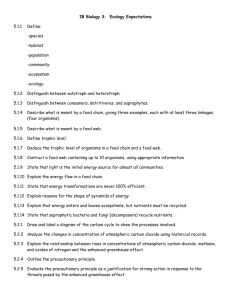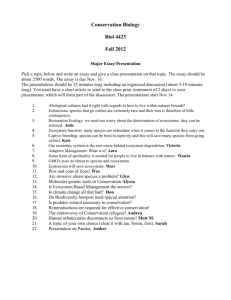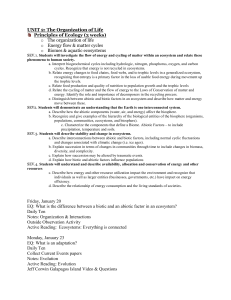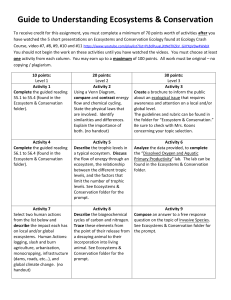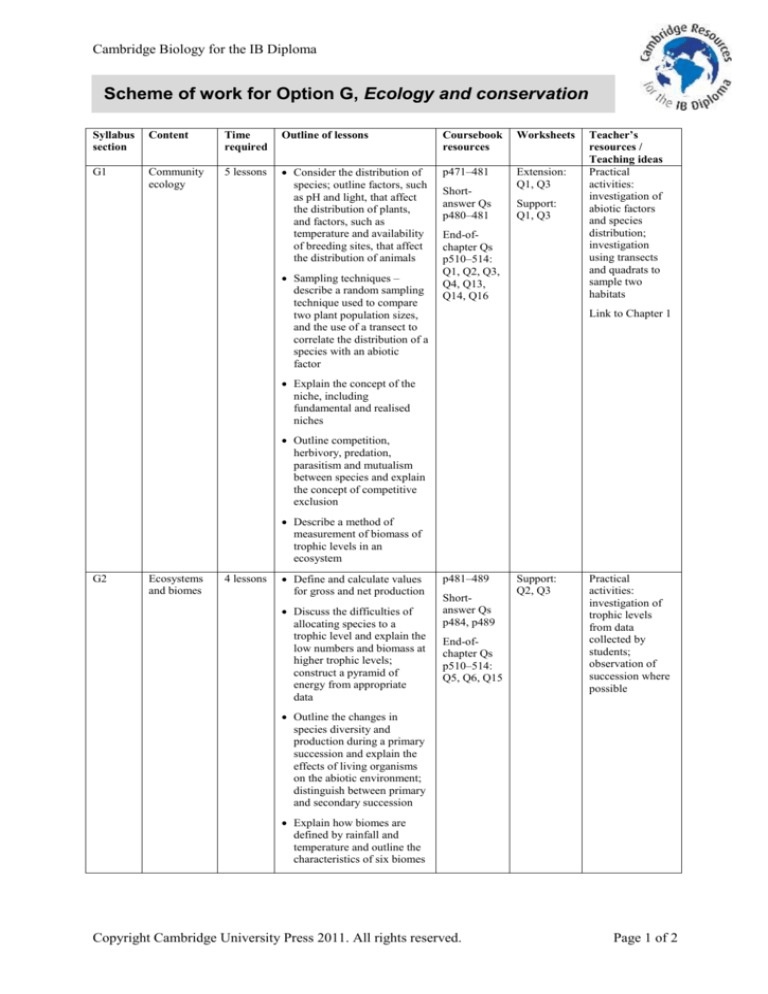
Cambridge Biology for the IB Diploma
Scheme of work for Option G, Ecology and conservation
Syllabus
section
Content
Time
required
Outline of lessons
Coursebook
resources
Worksheets
G1
Community
ecology
5 lessons
Consider the distribution of
species; outline factors, such
as pH and light, that affect
the distribution of plants,
and factors, such as
temperature and availability
of breeding sites, that affect
the distribution of animals
p471–481
Extension:
Q1, Q3
Sampling techniques –
describe a random sampling
technique used to compare
two plant population sizes,
and the use of a transect to
correlate the distribution of a
species with an abiotic
factor
Shortanswer Qs
p480–481
Support:
Q1, Q3
End-ofchapter Qs
p510–514:
Q1, Q2, Q3,
Q4, Q13,
Q14, Q16
Teacher’s
resources /
Teaching ideas
Practical
activities:
investigation of
abiotic factors
and species
distribution;
investigation
using transects
and quadrats to
sample two
habitats
Link to Chapter 1
Explain the concept of the
niche, including
fundamental and realised
niches
Outline competition,
herbivory, predation,
parasitism and mutualism
between species and explain
the concept of competitive
exclusion
Describe a method of
measurement of biomass of
trophic levels in an
ecosystem
G2
Ecosystems
and biomes
4 lessons
Define and calculate values
for gross and net production
Discuss the difficulties of
allocating species to a
trophic level and explain the
low numbers and biomass at
higher trophic levels;
construct a pyramid of
energy from appropriate
data
p481–489
Shortanswer Qs
p484, p489
End-ofchapter Qs
p510–514:
Q5, Q6, Q15
Support:
Q2, Q3
Practical
activities:
investigation of
trophic levels
from data
collected by
students;
observation of
succession where
possible
Outline the changes in
species diversity and
production during a primary
succession and explain the
effects of living organisms
on the abiotic environment;
distinguish between primary
and secondary succession
Explain how biomes are
defined by rainfall and
temperature and outline the
characteristics of six biomes
Copyright Cambridge University Press 2011. All rights reserved.
Page 1 of 2
Cambridge Biology for the IB Diploma
G3
Impacts of
humans on
ecosystems
5–6
lessons
Calculate and analyse the
biodiversity of two local
communities using the
Simpson index
Discuss the reasons for
conserving the biodiversity
of the rainforest
Using three examples,
discuss the impacts of
introduced alien species on
ecosystems; outline a
biological method of
controlling an invasive
species
p490–497
Shortanswer Qs
p497
Extension:
Q2, Q3
Practical
activities:
research of local
invasive species;
opportunity for
assessed practical
investigating the
effect of UV light
on algae; personal
research project
on the history and
use of DDT
Extension:
Q2
Practical activity:
investigation of
local indicator
species if possible
End-ofchapter Qs
p510–514:
Q7, Q8
Explain the cause and
consequences of
biomagnification (for
example, mercury in fish or
DDT in ecosystems)
Outline the effect of UV
light on tissues and
productivity and the effect
of CFCs on the ozone layer
which absorbs UV radiation
G4 (HL)
Conservation
of
biodiversity
3–4
lessons
Explain how indicator
species and biotic indices
are used to monitor
environments
Outline factors that
contributed to the extinction
of a named animal; outline
the features of nature
reserves that promote
conservation
Discuss active management
in conservation
p497–504
Worked
example
p500
Shortanswer Qs
p504
End-ofchapter Qs
p510–514:
Q9, Q10
Consider the advantages of
in situ and ex situ
conservation measures for
endangered species
G5 (HL)
Population
ecology
3–4
lessons
Discuss r-strategies and Kstrategies of producing
offspring and the
environmental conditions
that favour each
Describe the ‘capture-markrelease-recapture’ method of
estimating a population size
and the methods used to
estimate fish stocks
p505–510
TOK p510
Shortanswer Qs
p509
End-ofchapter Qs
p510–514:
Q11, Q12
Discuss international action
to promote the conservation
of fish stocks and the
concept of sustainable yields
Practical activity:
use of ‘capturemark-releaserecapture’ method
or a simulation of
it
Link to TOK:
international
cooperation in
conservation
programmes
Link to ICT:
obtaining data on
fish stocks;
databases
Note: 1 lesson = approximately 40 minutes
Copyright Cambridge University Press 2011. All rights reserved.
Page 2 of 2

